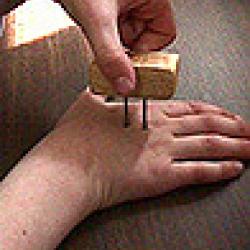Source Institutions
Source Institutions
Add to list Go to activity
Activity link broken? See if it's at the internet archive

In this activity, learners investigate the touch sensory system and discover how to plan and carry out their own experiments. In "CLASS EXPERIMENT," learners find that the ability to tell that two points rather than just one are pressing on the skin depends on two things: the density of skin sensory receptors and the connections that the sensory nerve cells make in the brain. They learn basic facts about sensory receptors and nerve connections, and use their estimates of receptor density to predict the size of the brain areas devoted to input from different skin regions. In "TRY YOUR OWN EXPERIMENT," learners design their own experiments, investigating, for example, how touch information is important in motor tasks, or whether additional sensory input can interfere with two-point discrimination. This lesson plan includes background information and guides for educators and learners. Note: total learning time may be reduced if the number of skin areas tested are limited and you restrict the materials in the second part of the activity.
- 10 to 30 minutes
- 1 to 2 hours
- $5 - $10 per group of students
- Ages 8 - 18
- Activity, Experiment/Lab Activity, Lesson/Lesson Plan
- English
Quick Guide
Materials List (per group of students)
- Toothpicks
- Corks of various sizes, up to 6 or 8 centimeters (cm) in at least one dimension
- Rulers (metric)
- Blindfolds (optional, do not share)
- Lego bricks of different sizes
- Small matching nuts and bolts
- Keyboard; e.g. from classroom computer
- Ice cubes
- Gloves, preferably cotton or ski liner gloves, not too thick
- Pieces of cotton or wool, or any fabric
- Vials with strong but harmless odors: ripe banana, cinnamon, perfume
- Tape player, tape (some teen-interest song), earphones
- Several timers or stopwatches
- Six to ten grades of sandpaper
- Several children's puzzles with just four to six pieces. These should have raised edges and if possible, should have pieces that go into separate cavities in the board.
Subjects
-
Life Sciences
-
Cells
- Cell Structure and Function
-
Human Body
- The Brain and Nervous System
- Muscles and Skin
-
Human Senses and Perception
- Touch
- Smell
- Vision
- Hearing
- Perception
-
Cells
-
Mathematics
-
Data Analysis and Probability
- Data Analysis
- Data Collection
- Data Representation
- Probability
- Measurement
-
Data Analysis and Probability
-
The Nature of Technology
-
The Design Process
- Problem Solving
-
The Design Process
-
The Nature of Science
-
The Scientific Process
- Asking Questions
- Conducting Investigations
- Gathering Data
- Formulating Explanations
- Communicating Results
-
The Scientific Process
Audience
To use this activity, learners need to:
- see
- read
- hear
- use keyboard
- smell
- touch
Learning styles supported:
- Involves teamwork and communication skills
- Involves hands-on or lab activities
Other
Components that are part of this resource:
Includes alignment to state and/or national standards:
This resource is part of:
Access Rights:
- Free access
By:
- Murray Ph.D., Marjorie A.
Rights:
- All rights reserved, Eric H. Chudler, 2009
